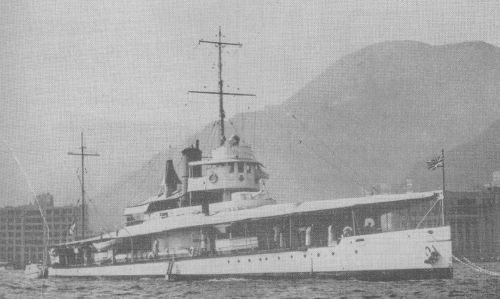- Author
- Francis, Richard
- Subjects
- Biographies and personal histories, History - Between the wars
- Tags
-
- RAN Ships
- HMAS Cerberus (Shore Establishment)
- Publication
- March 2002 edition of the Naval Historical Review (all rights reserved)
In a dark corner of the naval chapel at HMAS CERBERUS is a handsome brass plaque, to the memory of Commander Frederick Darley, Royal Navy, who had been reported killed in action against Chinese warlords on 5 September, 1926. He had previously served with the RAN at HMAS CERBERUS, while that establishment was being built. This is the story of his heroic demise in the course of active service with the China River Gunboat Flotilla.
At this period between WW I and WW II China was in a constant turmoil with local wars between competing warlords, during which Western nations continued to trade, particularly amongst the former Treaty Ports on the coast, and also up the mighty rivers inland, like the Yangtse. The Kuomintang Party began to emerge as the dominant force, led by General Chiang Kai-Shek, following the death of the founder of modern China, Sun Yat Sen.
Events in Wanshien City
In 1925 Chiang Kai-Shek commenced a push from his southern base against the northern warlords. Some 1500 miles inland from Shanghai was the province of Szechwan on the upper reaches of the Yangtse River, under the sway of a warlord, Marshal Wu Pei Fu. On 27 August a British steamer Wanhsien, of the China Navigation Company, lay anchored off the city of the same name, probably safe in the knowledge that the British gunboat, HMS Cockchafer (Lt Cdr Acheson. RN) was also anchored nearby. That evening calls for help were heard onboard the gunboat, and the Commanding Officer set out in his motor sampan to investigate.
Onboard SS Wanhsien he found a large party of solders under a Chinese local commander, named Kuro Gu Tung, who was demanding passage for his troops. LCDR Acheson did his best to explain that this was not possible as it could be construed as British support for the warlord, though this infuriated the Chinese commander. Kuro stated that there had been an earlier precedent for transport in a British ship, but Acheson replied that this had been at gunpoint, without the presence of a British gunboat. His deliberate intervention induced the troops to leave the Wanhsien.

On 29 August there was another similar incident at Yunyang, 25 miles downstream, involving another China Navigation vessel, SS Wanliu. While making a brief stop to disembark some passengers, 16 Chinese soldiers came onboard, and when the Master, Captain Lalor, observed several sampans loaded with other troops converging on his ship, he ordered full speed ahead on the telegraph, in an effort to get clear and avoid involvement. This caused some further excitement, when a badly-handled sampan collided with another in his wake, capsizing and drowning the occupants. SS Wanliu came under rifle fire from ashore and the Chinese troops already onboard tried to storm the bridge, but were beaten back by Captain Lalor and his officers with their revolvers.
On reaching Wanhsien city a short while later, Lalor anchored close to HMS Cockchafer. A naval boarding party was sent across, disarmed the Chinese troops and landed them by sampan. However, onshore these soldiers harangued a much larger group of troops who commenced aiming their rifles at SS Wanliu. Lt Cdr Acheson dispersed these by firing a burst from his Lewis gun in the water in front of them. Thankfully, SS Wanlui was able to continue upriver to Chunking, 300 miles further on.
Boarding of SS Wanhsien
Using this incident as a diversion, General Yang Sen, the provincial governor, boarded SS Wanhsien personally with over 400 troops, telling the Master, Captain Thomson (who had barricaded himself and his officers on the bridge) that until compensation was paid for the sampan allegedly sunk by the Wanlui, British river traffic would be brought to a standstill. Furthermore, negotiations would only be conducted with the British Consul in Chunking. The Chinese position was enhanced when later that evening another China Navigation steamer, SS Wantung, arrived at Wanhsien City. Captain Bates and his officers were imprisoned in the saloon after being boarded by over 300 Chinese troops. At the same time a further 200 soldiers took up positions on both banks of the river and Wanhsien waterfront itself, with artillery directed at HMS Cockchafer. Lt Cdr Acheson promptly cleared for action, but in the light of the British hostages in the steamers was unable to do more. The incident was becoming more sinister and almost out of control.




